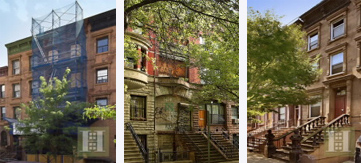Trending
Townhouse market hit hard in Harlem
 Harlem townhouses, left to right: 148 West 121st Street, 419 West 146th Street, 152 West 132nd Street
Harlem townhouses, left to right: 148 West 121st Street, 419 West 146th Street, 152 West 132nd Street
Townhouses have always been something of an anomaly, a frustratingly hard-to-track, hard-to-price sector of the real estate market.
And with so few annual sales, it’s hard to put too much stock in statistics about them.
Still, Streeteasy.com’s first-quarter market report figures on townhouses are eye-opening.
According to Streeteasy.com, which pulls its data from closed sales filed with the city, there were only 19 townhouses sold in the first quarter of 2009. That’s down a sizable 75.9 percent from 79 sales in the first quarter of 2008, according to Sofia Kim, vice president of research at Streeteasy and the author of the report.
Meanwhile, the median townhouse sales price fell 47.7 percent from the prior year quarter to $1.7 million, which Streeteasy.com attributed in part to the fact that more of the closings than typical were in Upper Manhattan, where the median townhouse sales price is $1.07 million. In comparison, the median townhouse sales price is $7.6 million on the Upper East Side, $7.282 million in Midtown, $5.5 million Downtown, and $978,295 on the Upper West Side, according to the report.
Of 19 closed townhouse sales, 10 of them were in Upper Manhattan, the report said, compared to four in Midtown, two on the Upper East Side, two Downtown and only one on the Upper West Side. While the number of transactions in Upper Manhattan tumbled 64.3 percent from the same quarter of last year, the percentage was still smaller than the other neighborhoods. The Upper West Side, for example, saw an annual decline of 90 percent.
Jonathan Miller, president of real estate appraiser firm Miller Samuel, said he hasn’t yet compiled data for townhouse sales in 2009, but he said he expects the number of townhouse sales this year to have decreased at roughly the same pace as co-ops and condos, which declined 47.6 percent in the first quarter from the same quarter of last year, according to a quarterly market report he prepared for Prudential Douglas Elliman. “It’s in line with what we’re seeing everywhere else,” Miller said.
He cautioned that trends in townhouse data aren’t always particularly telling because of the very small number of sales.
Townhouses all over the city face the same obstacles in the current economic environment, including the scarcity of jumbo and construction loans, and the crippling impact of stock market and Bernard Madoff losses on the formerly deep pockets of potential buyers.
But the super-high end market — which includes many townhouses south of 96th Street — is also suffering from the perception that ostentatious displays of wealth are passé, and even risky at a time when unemployment keeps climbing.
Therein may lie the relative strength of the Upper Manhattan townhouse market. Buyers view Harlem fixer-uppers as a value play, while townhouses in more established neighborhoods epitomize the height of luxury.
“The price sensitivity is probably the biggest factor,” said Norman Horowitz, an executive vice president at Halstead Property. “I’m seeing a lot of interest [in townhouses] under $1 million.”
Horowitz has around nine listings for Harlem townhouses priced at less than $1 million, a price point that was nearly unheard of at the height of the market. His listings include a 5,220-square-foot five bedroom house at 148 West 121st Street with an asking price of $995,000, and a 12-foot-wide home at 419 West 146th Street in Hamilton Heights on the market for $795,000.
According to Streeteasy.com, the average price of a townhouse in Upper Manhattan is $1.19 million, down 15.7 percent from the same quarter last year, while the median price fell 10.6 percent year-over-year.
Horowitz said much of his clientele are “value buyers” who are enticed primarily by the declining prices.
“You can buy 4,000 square feet of townhouse for under $1 million,” Horowitz said. “That’s under $250 a square foot. Compare that to Downtown luxury condos. Some of them are $2,000 per square foot.”
Rich Bouchner, a Harlem townhouse owner and managing director of the Commodore Property Group, a Manhattan-based mortgage broker and residential real estate sales firm, said the perceived value of Harlem real estate is a key reason buyers are attracted to the area.
Harlem is “one of the last places in the city where you can find townhouses and brownstones that are affordable,” Bouchner said. “I think people will come uptown who would have [typically] gone to the outskirts of Brooklyn and Queens.”




